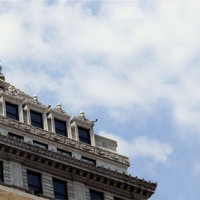Commerce Building
- Details
- Published on Sunday, 01 January 2012 16:36
- Written by Gary Wright
Architectural tour de force is Peoria business nerve center
There is no building more emblematic of Peoria. It commands the skyline, terra cotta clad and hands-on-hips proud, at the northeast corner of Jefferson and Main Streets. At night, with its façade awash in floodlights, its beacon beckons for miles like the glint of an exotic jewel.
The need for a substantial office building had been acknowledged since the turn of the century. In 1917, Peoria Life Insurance Company purchased the lot and engaged Peoria architects Hewitt & Emerson to draw up plans. Partner Frank Emerson was a brilliant architect who studied at the Ecole des Beaux Arts in Paris, France. His extraordinary talent for designing buildings in the classic style was heavily influenced by this experience. Emerson's signature style is artfully manifested in another of his Peoria masterpieces, the Hotel Pere Marquette.
The Peoria Life site was chosen for its historic as well as its practical significance. It was on this very spot that Rouse's Opera Hall had been erected. From the Hall's platform, Abraham Lincoln, Stephen Douglas and other luminaries spoke to heartland audiences. Mark Twain appeared there in 1869 during his Eastern Lecture Tour. Rouse's was also a platform for prominent entertainers of the age, foreshadowing Peoria's influence as a second tier vaudeville venue.
The building contract was let to V. Jobst & Sons of Peoria. Construction began in March of 1918, but was interrupted four months later in deference to the war effort, when the company diverted its investments to Liberty Bonds. Work resumed after the signing of the armistice and was completed in 1920.
A handful of owners have managed the building over the years, from Peoria Life to Alliance Life to First National Bank to Commerce Bank. Kert Huber and Dave Gulwitzer assumed ownership in February 2004 and now host 40 tenants in the Commerce Building. Commerce Bank occupies the first and second floors, and part of the third. The remaining tenants represent a mix of disciplines including law offices, health services, counseling, financial consulting and others.
From the outside, little has changed since Emerson penned his rhapsodic rendition nearly 90 years ago. The decorative flourishes and formal symmetry are pleasing to the eye. The building's footprint occupies 171 feet on Main Street by 100 feet on Jefferson. There are 17 stories, including six stories in the tower. The lantern atop the tower is 302 feet from the ground. More than 164,000 square feet of total rentable space is available to tenants.
Inside, cues to the era of the original construction abound. Spittoons mounted near elevator doors engender curiosity. Gas lamp fixtures sprout from walls – artifacts of illumination from the days before electricity was commercially available. In the tower section, twin hulking 1,000-gallon water tanks used for firefighting stand now in dry sentinel. Vintage elevator motors still hum smoothly to the demands of modern vertical commerce. In the high traffic areas, cream marble graces hallway walls. Floors are chicly dressed in terrazzo. The lobby, finished in white Italian marble, soars to a multi-colored, coffered ceiling. The original million-dollar investment would not begin to cover the cost of these precious materials today.
When the building was new in 1920, a local news dispatch reported some impressive numbers: 1,000 employees called it their work home; 6,500 people rode the elevators each day. The building opened at 85 percent rental occupancy despite gaunt economic conditions. A staff of 46 maintenance employees labored to keep it clean and functional.
According to current owner Kert Huber, the iconic Commerce Building is an essential historic structure filling the contemporary business needs of Peoria.
"Preservation and repurposing of important buildings like this satisfies a basic human need. This building gives us a tie to those who went before us. It's a monument to the past, and should be an inspiration to all Peorians," Huber said.
Huber was stimulated by the challenge of restoring the building to its former glory. He installed a new electrical system, plumbing lines and restrooms. There's an electronic entry system, state-of-the-art fire alarm system, expanded fire suppression system, smoke control in the stairways, additional fire exits, new solid-state elevator controls and new heating and air conditioning.
Rescuing historic buildings has become a resolute mission for Huber. He appreciates the character and strength of older buildings. Among those where he has intervened are: the Judge Jacob Gale House, circa 1838, which now houses a law office; the old Musicians' Hall on Kumpf Boulevard, an 1856 structure reborn as Busey Bank; Benassi and Benassi Law Offices; the Apollo Theater; and the Canton Opera House, now metamorphosed into the Opera House Professional Center. Other projects carrying the Huber touch are 401 Water, the Central Building, River Station, and Morton Professional Park.
The area of the Commerce Building with perhaps the most potent sensory impact is not available to the general public. Access to the tower room begins at the 16th floor. Three tightly wound metal spiral staircases spin to the summit – two counterclockwise and one clockwise – past the mechanical apparatus and "bones" of the building. The ascent through this space is dark and disorienting.
But at the summit, where the door opens to the balcony at the base of the lantern 40 feet above, the light is resplendent, the air fresh and bracing. The sweeping 360-degree vistas are breathtaking.
You can almost imagine Frank Emerson standing here, taking in the enchanting tableau and reveling in the height and breadth of his accomplishment.
Gary Wright is a retired communications and advertising executive who was manager of corporate communication at RLI Corp. for 22 years. A freelance writer, he focuses on historical pieces, including stories that helped shape Peoria and the region.\



















































